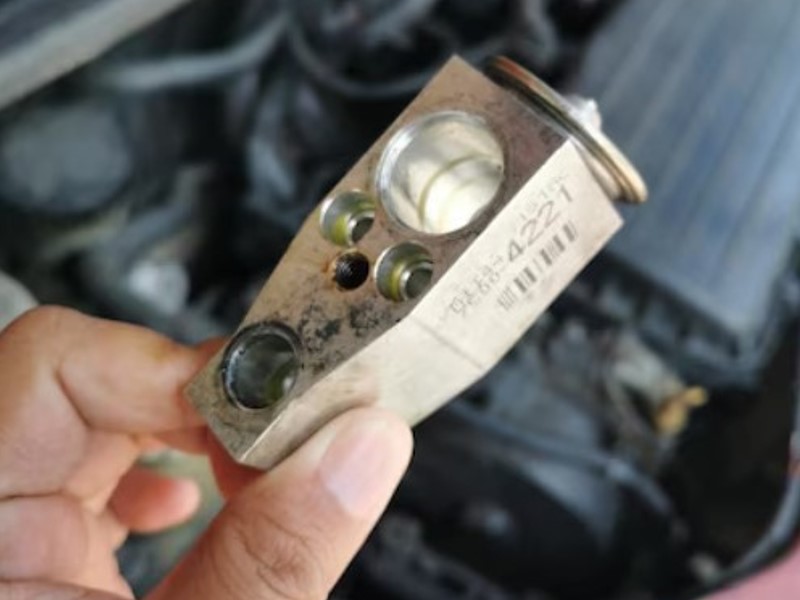Expansion Valve Basics
The air conditioning or AC system of your car consists of several components. One of these is none other than the orifice tube, more popularly called the expansion valve. Just like other parts of the AC system, even the smallest failure or malfunction of this valve can prevent proper cooling of the cabin.
Naturally, if your AC system doesn’t cool properly because of a faulty valve, your vehicle will become extremely uncomfortable. Once this happens, you need to fix the issue as soon as possible.
Table of Contents
What is the Expansion Valve?
The tiny metering device found between the AC compressor and the AC evaporator is called the expansion valve. The main function and purpose of this valve is to regulate the refrigerant as it flows it into the evaporator where it absorbs heat and cools the air circulated within the car.

The Function of Expansion Valves
You need to get some idea of how the AC system of your car works so that you can understand better the role of the expansion valve. All car AC systems use refrigerant as the primary heat transfer mechanism to get rid of the heat from the cabin. The process begins at the device known as the compressor.
The moment the engine is turned on and the AC system starts running, the compressor will then pressurize and distribute the vapour refrigerant into the system. Once the refrigerant leaves the compressor, it will enter the radiator-type device known as the condenser.
The condenser will then transfer a certain amount of heat to the atmosphere from the refrigerant. The refrigerant will also turn into a liquid form the moment it reaches the condenser.
The liquid refrigerant with its high pressure will then enter a restriction. This restriction reduces the refrigerant’s pressure and meters this into the next component of the system, which is another radiator-type device called the evaporator core.
Depending on the particular design of the system, the restriction will be either an expansion valve or an orifice tube. If it uses an expansion valve, a diaphragm inside the valve will function with a mechanism that can sense temperature to regulate the specific rate at which the refrigerant will get into the evaporator core.
From the evaporator core, a blower motor will force air through it to cause the heat from the air in the cabin to get transferred to the refrigerant. Meanwhile, the refrigerant also simultaneously boils and changes into a vapour with low pressure before heading back to the compressor to start the whole cycle all over again.
One more thing worthy to note here is that every AC system has a drier that eliminates moisture found on the lines. The systems with an expansive valve feature a receiver drier while systems that use an orifice tube count on the use of an accumulator drier.
The expansion valve functions by lowering the refrigerant’s pressure as it flows from the AC system’s high-pressure side after the compressor into the low-pressure side located before the evaporator. This valve contains a tiny orifice responsible for restricting the refrigerant flow to create a pressure drop that can make the refrigerant expand and transform into a low-temperature, low-pressure gas.
This valve works together with the AC condenser and compressor to retain the correct temperature and pressure levels within the AC system.
Once the refrigerant gas reaches the evaporator, it will absorb the heat from the air around it. This is cooled and then circulated through the cabin of the vehicle.
You should be ready to spend anywhere from $150 up to $400 if you need the expansion valve to be replaced by a professional mechanic.
Different Types of Expansion Valves
The expansion valves used in automotive AC systems come in two types: fixed orifice tubes and thermal expansion valves or TXVs. TXVs use a bulb that senses temperature to control the amount of refrigerant that flows through the system.
The moment this bulb senses extreme warmth in the evaporator, it will open the valve to allow the flow of more refrigerant. Once the evaporator becomes extremely cold, the valve will close and cut down the refrigerant flow.

On the other hand, a fixed orifice tube has an opening of a fixed size that lets a set quantity of refrigerant flow all over the system. It is a valve type that can’t adjust the refrigerant flow according to the temperature, which makes it less precise than a TXV.
Maintenance Tips for Expansion Valves
Expansion valves can malfunction or get clogged with debris after some time, which can lead to problems with the AC system of the car. Regular and proper maintenance of the car’s AC system, including replacing or cleaning the expansion valves, can prevent these problems.
Symptoms of Faulty Expansion Valves
The expansion valve of your vehicle, if it has one, can fail over time, resulting in any or even more of the symptoms below:
Warm Air Blowing from the AC
Expansion valves are only among the many issues that can make the AC system of your car blow just warm air alone. Once the valve becomes stuck closed, there will be a restriction in the flow of the refrigerator to the evaporator core. This can prevent the AC system from functioning as intended.
On the other hand, if the valve remains stuck open, flooding will occur in the evaporator core which can hinder the AC system from operating properly.
Accumulation of Frost
- Expansion valves that are stuck open will end up flooding the evaporator core, causing frost to gather at the outlet of the evaporator.
- A buildup of frost on the outer part of the valve, on the other hand, is an indication of a valve that is stuck closed, or clogged.
Buildup of Dye and/or Refrigerant Oil
The expansion valve can also develop leaks. Once this happens, refrigerant oil may accumulate around the valve. A green dye may also become noticeable if the dye is added at one point to the system.
Make sure you take care of the expansion valve to keep your vehicle cosy and comfortable.










